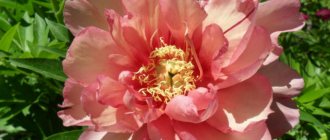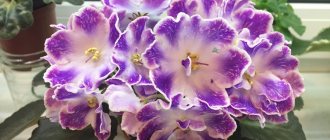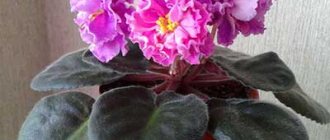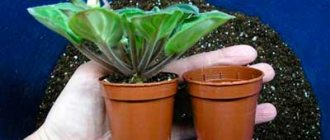Uzambara violet.
Family Gesneriaceae - Gesneriaceae.
Genus Saintpaulia hybrida - Hybrid Saintpaulia.
African violet saintpaulia hybrid.
Violets from breeders of the CIS countries - “D” (EK).
EK- Dolce Vita (E. Korshunova).
EK-Dolche Vita (E. Korshunova)..
Very large (6 cm) double wavy coral-pink stars with a wide crimson-purple frill along the edge of the petals. The sport EK-Love and Pigeons (E. Korshunova) is registered from him.
Her rosette is really very neat and does not grow from flowering to flowering. Standard.
The border and fantasy are beautiful. 4-5 huge flowers bloom on one peduncle, and strong peduncles can withstand all this beauty.
The peculiarity of this variety is that they gain their beauty some time after flowering. At first, the flowers appear ugly, with small petals and large stamens, the color is pale. And then the flower grows, enlarges and gains brightness. It blooms for a long time, the others have time to grow and catch up. In acidic soil the color becomes more vibrant.
Dolce vita is an Italian phraseological unit. It means the “sweet life” of rich, satiated people in bourgeois society. Also a film by F. Fellini (1959).
Do you know that…?
The tendency to sapling is a varietal trait or an error in agricultural technology. In some varieties it is very pronounced, in others it is not. Stepchildren on miniature and semi-miniature varieties are a nuisance much more often than on standard varieties of violets. And often the massive appearance of stepsons indicates that the first flower stalks will soon appear. Both children and adult plants produce stepsons; you need to regularly check them for stepchildren. Stepchildren need to be mercilessly removed, but pay closer attention; sometimes tiny flower stalks already appear next to the stepchildren.
Before you buy the violets listed below, carefully read the forums about their behavior on the windowsill. Many of them are very beautiful flowers. However, these can be large rosettes with large and fragile leaves, with leaves rising up or hugging the pot, forming many stepsons that interfere with the formation of a neat rosette, pulling the stem up and growing into a Christmas tree, bending the trunk, rare flowering with long breaks, fallen flowers or they last little and quickly wither, very long and recumbent peduncles, the color of the flower fades quickly, they do not like bright lighting on the windowsill, they are afraid of the slightest drying out or waterlogging, a large percentage of them go into sports or darken the flower.
Are they suitable for your window sill and the conditions that you can create for them? You will look at the flowers for several months, and the rosette will always be in front of your eyes. There are many beautiful flowers, there are much fewer beautiful and neat rosettes, look first at the rosette! Search and you may find a dozen violets with the same flower color if you are not interested in the smallest details as a collector.
• — Lady with Camellias (Korshunova); • — Victory Day (Korshunova); • — Birthday (Korshunova); • — Amazon Jungle (Korshunova);
Today, on the windowsills of avid flower growers, you can see a variety of representatives of the violet family: with patterns, inclusions, spots, stripes, stains and contrasting borders.
One of the interesting varieties of violets with richly colored buds is Dolce Vita. Its huge bright flowers will not leave any collector indifferent, and caring for it will be a real pleasure.
Description, photographs and features of the variety
Dolce Vita violets are another development of the domestic breeder Elena Korshunova, who introduced this magnificent variety to the world in 2005. The Italian phraseology “Dolce vita” means “sweet life” or “not life, but raspberries,” as evidenced by the rich coral-pink palette of flowers. Today, two sports are officially registered from Dolce Vita - Love and Pigeons.
According to the description, these violets have a neat emerald rosette and double wavy coral-pink flowers with a wide crimson-purple edging along the border of the petals, which can be seen in the photo. The flowers reach 6 cm in diameter and are shaped like stars. They do not have a pronounced aroma.
According to the description, the variety has several characteristic features:
- the rosette has a standard size and does not grow from flowering to flowering;
- fairly strong flower stalks can support 4-5 large flowers;
- all the beauty of these violets begins to appear some time after blooming: at first the flowers are pale in color and have small petals and large stamens, over time they begin to increase in size and gain brightness;
- the plant blooms for a long time, the remaining flowers have time to grow and catch up;
- When grown in acidic soil, the color becomes more intense.
Description of the plant
A vigorous, dense bush can reach a height of 1.5-2 m, growing up to 1 m in width, while maintaining a neat, elegant shape. The erect shoots are strong and long, not too leafy, densely covered with sharp reddish-brown thorns. The leaves are medium sized, green, matte. The leaf blade is elongated, with a jagged edge and a recessed middle part.
Bloom
Belonging to the re-blooming varieties, “Dolce Vita” demonstrates two, and in favorable conditions, three long waves of lush, abundant flowering. The first buds appear on the bush in early June, and the last flowers last until mid-October. On long stems, flowers are arranged singly or in inflorescences of 2-4 pieces.
The large salmon-colored bud is elongated, with a pointed top, and opens slowly, taking on the shape of a classic glass. A double flower can contain from 26 to 40 petals, reaching 10-12 cm in diameter when fully bloomed. The color of the petals changes as they open: salmon-pink when half-opened, they gradually fade to a soft pink color, while their edges turn pale, and the middle of the flower looks like a dense cone and retains its original color. The petals are velvety, their edges bent downwards gradually curl, forming sharp corners.
The buds are borne on the stems one at a time or in small inflorescences consisting of 2-4 pieces
Roses of this variety are characterized by a pleasant soft aroma. Cut flowers remain fresh for a long time in a vase with water, for which they are highly valued by florists.
Basic rules of care and maintenance
Properly growing violets and caring for them is a whole science. A factor in healthy growth and flowering is compliance with a number of rules, from organizing the correct location to the ability to feed a plant in need in a timely manner.
Location and lighting
Representatives of the Dolce Vita variety love good, but diffused light. To ensure that violets receive a sufficient amount of natural light, it is advisable to place them on windows facing east or west. Placing it on the south side can cause sunburn on the leaves, so in this case the pot is placed on a table opposite the window sill, and the window panes are shaded with a curtain or mosquito net to diffuse the rays.
Subject to artificial lighting, violets require a 12-hour daylight hours, provided by fluorescent lamps.
Temperature and humidity
The optimal temperature at which violets exist comfortably is 18-22 degrees throughout the year. Humidity in the room should be maintained at 50-60%, so if the air is excessively dry, humidifiers and the old method of hanging wet towels on radiators are used.
The Dolce Vita violet requires an air humidity of about 60%.
Interesting. Some gardeners claim that if you leave the plant alone for 6 weeks at a low temperature (13-15 degrees) and reduced watering, the flowering will be more abundant and larger. This technique stimulates the setting of more flower buds and can be used at any time of the year.
Watering
Violets are watered on average 2-3 times a week, depending on the characteristics of the soil, air humidity and season. Water for irrigation should be at room temperature and allowed to stand for at least 24 hours. You can use melted, boiled or filtered water.
Features of home care
Double violets generally require the same care as other members of the violet genus. The biggest whim of terry ones is strict adherence to the light regime .
Content Basics
It is recommended to keep double violets indoors or in greenhouses with air humidity maintained at least 60-80%. At the same time, do not forget about:
- Regular watering;
- And feeding the plants with specialized preparations.
Preventive measures against pests
To avoid infection by harmful insects, it is necessary to regularly spray and wipe the leaves . Also, it is necessary to periodically replant the flower and get rid of it from limp leaves and dry inflorescences.
Requirements for transplanting Dolce Vita violets
Typically, young or adult plants are replanted once every 1-3 years, in the spring season. This should be done when the violets become cramped in the pot. Regardless of the time of year, it is not recommended to replant flowering plants, only in emergency cases (parasites, acidified soil, etc.) to save the flower.
Soil composition
Transplanting violets begins with preparing the substrate and container.
Like all representatives of the violet family, the Dolce Vita variety loves acidic soils, which should include:
- peat – 3 parts;
- leaf soil - 5 parts;
- coarse river sand – 1 part;
- sphagnum and charcoal, the share of which does not exceed 10% of the total mass of components.
Experienced florists recommend adding perlite or vermiculite to the substrate, which have moisture-retaining properties, which is very important for such light and loose soil.
Capacity requirements
Dolce Vita violets do not need pots that are too large or deep.
To prevent the substrate from turning sour and leading to rotting of the roots, there should not be a lot of it. For adult specimens, small pots with a diameter and height of about 10 cm are suitable.
This amount of soil will be enough, despite the fact that the container is half filled with drainage. The preferred material for the pot is plastic.
To flower, you need to wait until the root system completely fills the pot with soil. The diameter of the first container for a young plant should be about 6 cm. The drainage hole in the pot should be of a good size.
Features of transplantation
The process of transplanting violets has some nuances that should not be neglected:
- when the roots are buried in the ground, the lower leaves should be at ground level;
- When transplanting, the earthen lump should be moist, but not stick to your hands;
- on the first day after planting, it is necessary to ensure a thermal effect by covering with a plastic bag;
- You can water the plant only the next day;
- You should not use old pots with salt deposits as containers.
Dolce Vita violets can be replanted in three ways: with a complete replacement of the soil, with partial replacement, and with the transshipment method. The first method is an ideal option in case of acidification of the soil, exposed stems of adult plants, and wilting of flowers.
Partial replacement is acceptable when young violets need to be replanted. In the case of transplanting flowering plants, the transshipment method is appropriate.
Methods of propagation of the variety
It is better to propagate Dolce Vita violets using the leaf method. The cuttings are cut at an angle and left for 30 minutes until completely dry. After this, it is placed in a dark jar of water or buried in the ground. In the first case, the water must be melted, for example, when defrosting a refrigerator.
Dolce Vita violet can be propagated by leaf rooting.
The bubble with the leaf is located in a bright place without drafts or direct sunlight. After 30-40 days, the first roots can be observed. When their length reaches 2-3 cm, the leaves are transplanted into small pots with an earthen mixture.
The seedlings are buried into the soil no more than 1-2 cm. To provide support for the young plant, it is tied to a straw or wooden stick. The container with the flower is covered with film and again sent to a bright room. The film cover can be removed after a couple of weeks.
When sprouts 4 cm high appear near the cuttings, they are separated and transplanted into small pots with a diameter of 4 cm. When the root system completely fills the space of the pot, the violets are transplanted into larger containers.
If leaf cuttings are germinated in soil, then for these purposes a special soil composition is taken: coarse sand, peat, leaf soil in a ratio of 4:1:2, with the addition of birch charcoal (1 spoon per 1 liter of substrate). In soil, cuttings take root more slowly than in water, but they tolerate replanting more easily and adapt faster.
How does a flower reproduce?
The only suitable propagation method for the Dolce Vita rose is cuttings. It is useless to plant seeds - it is a hybrid. It is impossible to obtain new specimens from layering - erect, strong shoots cannot be bent to the ground. In principle, it is possible to divide a bush if you are willing to take a risk. It is very likely that you will not receive several copies, but will lose the only one.
Rose cuttings are parts of a shoot 12–15 cm long with 3–4 growth buds. They are cut in June. In order for the cuttings to take root, the lower cut (made at an angle) is immersed in a biostimulant solution for several hours, then planted in a damp mixture of peat and humus at a slight slope. Cover the top of the container with a plastic bag and a plastic bottle. Rooting takes 3-4 weeks, and next spring the roses can be planted in a flower bed.
Cuttings are a vegetative method of propagation; accordingly, the varietal characteristics of the rose are completely preserved
Video: propagation of roses by cuttings
Diseases and pests and methods of combating them
Dolce Vita violets are quite resistant to diseases, but there are a number of factors that affect the health of a houseplant. The main causes of disease can be heavy soil, cold air, too spacious a pot, drafts, direct exposure to the sun, cold water, lack of light, etc.
The most dangerous disease is considered to be late blight, which occurs due to fungal etiology. Obvious symptoms are brown spots on plant leaves. For prevention purposes, you should maintain optimal humidity in the room and fertilize the soil with superphosphate.
Attention. Treatment of late blight is ineffective, so diseased violets are destroyed. Since fungal spores live in the soil for a long time, the pot after the affected plant is thoroughly sterilized.
Dolce Vita violet may suffer from fusarium or late blight.
As a result of improper care, another disease can occur - fusarium. After the Fusarium fungus enters, the following picture is observed: the petioles of the leaves acquire a brown tint, the roots darken and begin to easily separate from the ground. As a therapeutic measure, spraying with fungicides is used, while rotten and dried parts of the plant are removed.
Gray rot appears as a white coating on flowers, leaves and petioles. The disease develops rapidly and can lead to the death of the violet. The main drugs for the treatment of gray rot are fungicides.
Possible problems during cultivation
The variety’s good immunity against fungi allows one to limit the development of diseases to two preventive treatments - at the beginning and at the end of the season. The soil under the bush is spilled with a solution of any fungicide, and the shoots are sprayed with it. If weather favorable for the development of fungi sets in for a month or more, treatments are repeated at intervals of 2–2.5 weeks.
Copper-containing preparations are harmful to pathogenic fungi
Pests do not have much love for the Dolce Vita rose. Growing practice shows that it is most often attacked by thrips. The pests themselves look like small black sticks; small beige dots and thin silvery streaks remain on the leaves. At the first signs of infection, the bush and the soil underneath it are sprayed with a solution of any universal insecticide (Aktara, Inta-Vir, Iskra-Bio).
Thrips feed on plant sap, and the rose they infect gradually dries and dies.
Some tips from flower growers
With proper care, Dolce Vita violets will reward you with lush and amazingly beautiful flowering. On average, these plants bloom for about two months, and gardeners recommend promptly removing faded flowers.
In winter, violets require special care, especially with regard to lighting. Since daylight hours are shorter in winter, it is advisable to increase it using artificial lighting lamps.
These beauties do not tolerate waterlogging of the soil, excess humid air and spraying of foliage. The plant is cleaned of dust exclusively in the shower, but taken out in a dry state.
Violet growers also recommend not growing violets next to large plants such as ficus and palm trees. They can serve as sources of mites, aphids and thrips. It is useful to place geranium next to the violet, which repels pests, and spathiphyllum, which moisturizes the air well.
Reviews from flower growers about the variety
Flower growers note that the Dolce Vita violet has a compact rosette.
Veronica. During the first flowering, Dolce Vita produced several flower stalks with elastic buds, but they took a very long time to open. The rosette is compact, there are quite a lot of flowers. Even in forty-degree heat it blooms well.
Love. The rosette of these violets is very neat and does not grow from flowering to flowering. During the first flowering period the color was light. Now I keep them on a shelf under a white and pink lamp, the brightness becomes more saturated. The soil mainly consists of peat, which also affects the color. In love with Dolce Vita forever.
Today, on the windowsills of avid flower growers, you can see a variety of representatives of the violet family: with patterns, inclusions, spots, stripes, stains and contrasting borders.
One of the interesting varieties of violets with richly colored buds is Dolce Vita. Its huge bright flowers will not leave any collector indifferent, and caring for it will be a real pleasure.
You can purchase violets, streptocarpus, pelargoniums and much more on our website!
Home Menu ↓
Skip to main content
Skip to additional content
- home
- Shop
- Basket
- Order conditions
- Buyer's Corner
- Profile Log out
- Forgot your password?
- Change my address
- Change password
- View order
Description, photographs and features of the variety
Dolce Vita violets are another development of the domestic breeder Elena Korshunova, who introduced this magnificent variety to the world in 2005. The Italian phraseology “Dolce vita” means “sweet life” or “not life, but raspberries,” as evidenced by the rich coral-pink palette of flowers. Today, two sports are officially registered from Dolce Vita - Love and Pigeons.
According to the description, these violets have a neat emerald rosette and double wavy coral-pink flowers with a wide crimson-purple edging along the border of the petals, which can be seen in the photo. The flowers reach 6 cm in diameter and are shaped like stars. They do not have a pronounced aroma.
According to the description, the variety has several characteristic features:
- the rosette has a standard size and does not grow from flowering to flowering;
- fairly strong flower stalks can support 4-5 large flowers;
- all the beauty of these violets begins to appear some time after blooming: at first the flowers are pale in color and have small petals and large stamens, over time they begin to increase in size and gain brightness;
- the plant blooms for a long time, the remaining flowers have time to grow and catch up;
- When grown in acidic soil, the color becomes more intense.
Basic rules of care and maintenance
Properly growing violets and caring for them is a whole science. A factor in healthy growth and flowering is compliance with a number of rules, from organizing the correct location to the ability to feed a plant in need in a timely manner.
Location and lighting
Representatives of the Dolce Vita variety love good, but diffused light. To ensure that violets receive a sufficient amount of natural light, it is advisable to place them on windows facing east or west. Placing it on the south side can cause sunburn on the leaves, so in this case the pot is placed on a table opposite the window sill, and the window panes are shaded with a curtain or mosquito net to diffuse the rays.
Subject to artificial lighting, violets require a 12-hour daylight hours, provided by fluorescent lamps.
Temperature and humidity
The optimal temperature at which violets exist comfortably is 18-22 degrees throughout the year. Humidity in the room should be maintained at 50-60%, so if the air is excessively dry, humidifiers and the old method of hanging wet towels on radiators are used.
The Dolce Vita violet requires an air humidity of about 60%.
Interesting. Some gardeners claim that if you leave the plant alone for 6 weeks at a low temperature (13-15 degrees) and reduced watering, the flowering will be more abundant and larger. This technique stimulates the setting of more flower buds and can be used at any time of the year.
Watering
Violets are watered on average 2-3 times a week, depending on the characteristics of the soil, air humidity and season. Water for irrigation should be at room temperature and allowed to stand for at least 24 hours. You can use melted, boiled or filtered water.
The best way to water is through a tray - in this case, moisture does not fall on the foliage and petals and prevents them from rotting. The plant will absorb the required amount of water, and the remaining is drained after 12-15 minutes.
An equally convenient way is immersion. To do this, place the flower pot in a container of water and leave for 15 minutes. The soil is saturated, after which the pot is removed and excess water is drained.
When watering from above, movements are carried out along the walls so that water does not fall on the outlet.
Feeding and fertilizers
Of the fertilizers, Dolce Vita violets especially need mineral ones: phosphorus, which promotes abundant flowering, and nitrogen, which is responsible for healthy growth and the formation of new shoots.
Dolce Vita violets require mineral supplements.
Once a year, a humate solution is added to the soil, and mineral fertilizers are added during the period of active growth and flowering. The main thing is to avoid overfeeding. The soil of violets should always be in a slightly thin state.
Requirements for transplanting Dolce Vita violets
Typically, young or adult plants are replanted once every 1-3 years, in the spring season. This should be done when the violets become cramped in the pot. Regardless of the time of year, it is not recommended to replant flowering plants, only in emergency cases (parasites, acidified soil, etc.) to save the flower.
Soil composition
Transplanting violets begins with preparing the substrate and container.
Like all representatives of the violet family, the Dolce Vita variety loves acidic soils, which should include:
- peat – 3 parts;
- leaf soil - 5 parts;
- coarse river sand – 1 part;
- sphagnum and charcoal, the share of which does not exceed 10% of the total mass of components.
Experienced florists recommend adding perlite or vermiculite to the substrate, which have moisture-retaining properties, which is very important for such light and loose soil.
Capacity requirements
Dolce Vita violets do not need pots that are too large or deep.
To prevent the substrate from turning sour and leading to rotting of the roots, there should not be a lot of it. For adult specimens, small pots with a diameter and height of about 10 cm are suitable.
This amount of soil will be enough, despite the fact that the container is half filled with drainage. The preferred material for the pot is plastic.
To flower, you need to wait until the root system completely fills the pot with soil. The diameter of the first container for a young plant should be about 6 cm. The drainage hole in the pot should be of a good size.
Features of transplantation
The process of transplanting violets has some nuances that should not be neglected:
- when the roots are buried in the ground, the lower leaves should be at ground level;
- When transplanting, the earthen lump should be moist, but not stick to your hands;
- on the first day after planting, it is necessary to ensure a thermal effect by covering with a plastic bag;
- You can water the plant only the next day;
- You should not use old pots with salt deposits as containers.
Dolce Vita violets can be replanted in three ways: with a complete replacement of the soil, with partial replacement, and with the transshipment method. The first method is an ideal option in case of acidification of the soil, exposed stems of adult plants, and wilting of flowers.
Partial replacement is acceptable when young violets need to be replanted. In the case of transplanting flowering plants, the transshipment method is appropriate.
Planting, transplanting, necessary preparation
Preparation for planting begins with choosing a suitable seedling, the optimal age of which is 2–3 years. It is necessary to have 3–5 shoots with a diameter of about 0.5 cm and a length of 20–25 cm, with a developed root system. Stems and roots should be flexible and elastic, uniform in color. Peeling, suspicious stains, mold, areas of dried and rotten fabrics are a reason to refuse the purchase.
High-quality planting material is the key to abundant rose flowering, so seedlings must be selected very carefully
This variety of rose can be planted in both spring and autumn. In regions with a temperate and less suitable climate for gardening, the best time for the procedure is the second half of April and May. In the south of Russia, roses are planted throughout September and until the 20th of October.
Methods of propagation of the variety
It is better to propagate Dolce Vita violets using the leaf method. The cuttings are cut at an angle and left for 30 minutes until completely dry. After this, it is placed in a dark jar of water or buried in the ground. In the first case, the water must be melted, for example, when defrosting a refrigerator.
Dolce Vita violet can be propagated by leaf rooting.
The bubble with the leaf is located in a bright place without drafts or direct sunlight. After 30-40 days, the first roots can be observed. When their length reaches 2-3 cm, the leaves are transplanted into small pots with an earthen mixture.
The seedlings are buried into the soil no more than 1-2 cm. To provide support for the young plant, it is tied to a straw or wooden stick. The container with the flower is covered with film and again sent to a bright room. The film cover can be removed after a couple of weeks.
When sprouts 4 cm high appear near the cuttings, they are separated and transplanted into small pots with a diameter of 4 cm. When the root system completely fills the space of the pot, the violets are transplanted into larger containers.
If leaf cuttings are germinated in soil, then for these purposes a special soil composition is taken: coarse sand, peat, leaf soil in a ratio of 4:1:2, with the addition of birch charcoal (1 spoon per 1 liter of substrate). In soil, cuttings take root more slowly than in water, but they tolerate replanting more easily and adapt faster.
Diseases and pests and methods of combating them
Dolce Vita violets are quite resistant to diseases, but there are a number of factors that affect the health of a houseplant. The main causes of disease can be heavy soil, cold air, too spacious a pot, drafts, direct exposure to the sun, cold water, lack of light, etc.
The most dangerous disease is considered to be late blight, which occurs due to fungal etiology. Obvious symptoms are brown spots on plant leaves. For prevention purposes, you should maintain optimal humidity in the room and fertilize the soil with superphosphate.
Attention. Treatment of late blight is ineffective, so diseased violets are destroyed. Since fungal spores live in the soil for a long time, the pot after the affected plant is thoroughly sterilized.
Dolce Vita violet may suffer from fusarium or late blight.
As a result of improper care, another disease can occur - fusarium. After the Fusarium fungus enters, the following picture is observed: the petioles of the leaves acquire a brown tint, the roots darken and begin to easily separate from the ground. As a therapeutic measure, spraying with fungicides is used, while rotten and dried parts of the plant are removed.
Gray rot appears as a white coating on flowers, leaves and petioles. The disease develops rapidly and can lead to the death of the violet. The main drugs for the treatment of gray rot are fungicides.
Widespread pests include:
- Scale insects deforming plant leaves. The bite sites turn into brownish spots. The most effective drugs in treatment are Aktara, Fitoverm and Actellik.
- Aphids attacking flowers and peduncles. These parasites feed on the juice of violets, which leads to poor growth, deformation and wilting of the petals. High-quality products in the fight against aphids are Actellik and Mospilan.
- Mites that threaten to dry out and deform the leaves. Small brown or white-yellow spots are visible to the naked eye on the leaf blades, the rosette becomes denser, and a grayish coating appears at the base of the leaves. Treatment is carried out using the drugs Akarin, Actellik and Fitoverm.
The leaves and flowers of Dolce Vita violet can be damaged by various pests.
Some tips from flower growers
With proper care, Dolce Vita violets will reward you with lush and amazingly beautiful flowering. On average, these plants bloom for about two months, and gardeners recommend promptly removing faded flowers.
In winter, violets require special care, especially with regard to lighting. Since daylight hours are shorter in winter, it is advisable to increase it using artificial lighting lamps.
These beauties do not tolerate waterlogging of the soil, excess humid air and spraying of foliage. The plant is cleaned of dust exclusively in the shower, but taken out in a dry state.
Violet growers also recommend not growing violets next to large plants such as ficus and palm trees. They can serve as sources of mites, aphids and thrips. It is useful to place geranium next to the violet, which repels pests, and spathiphyllum, which moisturizes the air well.











